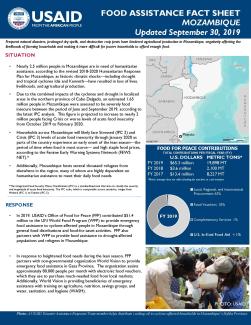September 30, 2019
Frequent natural disasters, prolonged dry spells, and destructive crop pests have hindered agricultural production in Mozambique, negatively affecting the livelihoods of farming households and making it more difficult for poorer households to afford enough food.
Situation
- Nearly 2.5 million people in Mozambique are in need of humanitarian assistance, according to the revised 2018-2020 Humanitarian Response Plan for Mozambique, as historic climatic shocks—including drought and tropical cyclones Idai and Kenneth—have resulted in loss of lives, livelihoods, and agricultural production.
- Due to the combined impacts of the cyclones and drought in localized areas in the northern province of Cabo Delgado, an estimated 1.65 million people in Mozambique were assessed to be severely food insecure between the period of June and September 2019, according to the latest IPC analysis. This figure is projected to increase to nearly 2 million people facing Crisis or worse levels of acute food insecurity from October 2019 to February 2020.
- Households across Mozambique will likely face Stressed (IPC 2) and Crisis (IPC 3) levels of acute food insecurity through January 2020 as parts of the country experience an early onset of the lean season—the period of time when food is most scarce— and high staple food prices, according to the Famine Early Warning Systems Network (FEWS NET).*
* The Integrated Food Security Phase Classification (IPC) is a standardized tool that aims to classify the severity and magnitude of food insecurity. The IPC scale, which is comparable across countries, ranges from Minimal (IPC 1) to Famine (IPC 5).
Response
- In 2019, USAID’s Office of Food for Peace (FFP) contributed $51.4 million to the UN World Food Program (WFP) to provide emergency food assistance to cyclone-affected people in Mozambique through general food distributions and food-for-asset activities. FFP also partners with WFP to provide food assistance to drought-affected populations and refugees in Mozambique
- In response to heightened food needs during the lean season, FFP partners with non-governmental organization World Vision to provide emergency food assistance in Gaza Province. The organization assists approximately 80,000 people per month with electronic food vouchers, which they use to purchase much-needed food from local markets. Additionally, World Vision is providing beneficiaries of emergency assistance with training on agriculture, nutrition, savings groups, and water, sanitation, and hygiene (WASH).
Food for Peace Contributions
Total Contributions:
| U.S. Dollars | Metric Tons | |
|---|---|---|
| Fiscal Year 2019 | $65.3 million | 19,898 MT |
| Fiscal Year 2018 | $3.6 million | 2,100 MT |
| Fiscal Year 2017 | $13.4 million | 8,277 MT |
* Metric tonnage does not reflect funding for vouchers or cash transfers.
Related Resources


